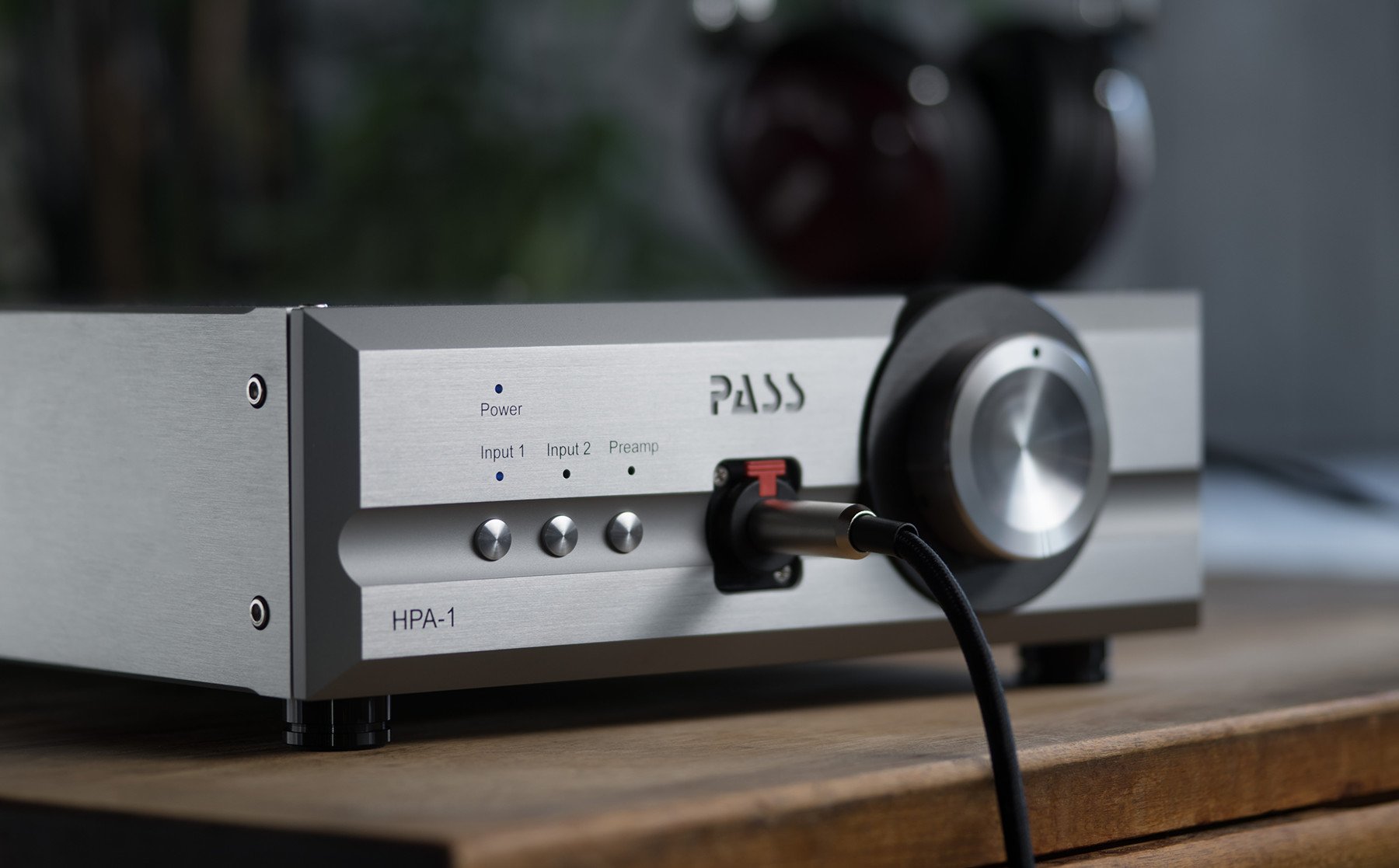PASS LABS HPA-1 HEADPHONE AMP - REVIEW
PASS LABS HPA-1 HEADPHONE AMP
Quite some time ago, I owned a full PASS LABS system, complete with its XP-30 preamplifier, XP-25 phonostage preamplifier, and XA200.5 monoblock amplifiers, if I remember correctly. The balance of the system was the Transroter Fat Bob Special turntable, a pair of Eggleston Works Andra II speakers, and the Audio Aero Capitole CD player. I don’t actually remember the cartridge.
I believed it was a good system at the time, though wholly dependent on the proper setup of the Andra IIs, which were more musical than accurate and which could be problematic if not set up properly, not unlike most speakers. Though once dialled in, the system was very musical and engaging. It did, however, heat up the room by at least 15 to 20 degrees, making it nice and toasty in my San Francisco digs. Too bad I wasn’t living in Montreal or Minnesota then.
In the interim, I have owned many two-channel stereo systems, from the quite simple, with a pair of stand-mounted speakers, to the quite kitted-out, with speakers standing nearly six feet above the floor. In recent years, I have discovered the headphone world in its many flavors—electrostatic, dynamic, planar, In-Ear-Monitors and the amplification that favors them. It has been a wonderful education, and I have discovered some true gems—the Blue Hawaii Special Edition electrostatic headphone amplifier, the Aurorasound HEADA headphone amplifier, the Dan Clark CORINA electrostatic headphone, Meze Audio Empyrean planar magnetic headphones, the ABYSS AB1266 Phi TC planar headphones—that still top our “Best of” categories.
The topic of this review represents a return to PASS LABS and its long-standing headphone amplifier, the HPA-1. It is kitted-out as one would expect of PASS LABS, in a simple, clear, straight-to-business way that is neither kitschy nor overly serious, but very practical. But how does it sound?
REFRAIN: Unlike most reviews, this review will be non-sequential, as it will start with how the component actually sounds and not the process of physically “undressing” it and/or laying out its various parts, specifications, etc. Think of this review then, as a non-linear movie—Memento, Kill Bill, Arrival, Eternal Sunshine of the Spotless Mind, etc—that, likewise, starts at the end and winds its way to the beginning.
THE SYSTEM
Baetis Audio 4 Reference Mingo Streamer
Silent Angel Rhein Z1 Streamer
Silent Angel Bonn Pro Network Switch
Bricasti Design M1SE DAC
ALLNIC OTL/OCL DAC-10000 DAC
ALLNIC OTL/OCL HPA-10000 Headphone Amp
Aurorasound HEADA Headphone Amp
Abyss AB1266 Phi TC Headphones
Meze Empyrean Headphones
ZMF Véríté Headphones
Audience Front Row Cables/Wires
Kubala-Sosna Cables
Black Cat TRØN Signature Digital Cable
TORUS AUDIO RM20 Power Conditioner
THE SOUND
The PASS LABS HPA-1 is rated to have 3.5 watts into 20 Ohms, which I believed sufficient to drive the, well, inefficient ABYSS AB1266 Phi TC (88 dB/mW, 50 Ohms) planar headphones. I also utilized Meze Audio’s Empyreans (100 dB/mW, 31.6 Ohms), which presented a far easier load for the HPA-1. This was a test of sorts to see the HPA-1 sailing easily in an efficient sea, as well as the HPA-1 in a roiling storm on an inefficient and tumultuous sea.
When initially placed into the system, before any burn-in, I took a “sounding” of the HPA-1 and was concerned as to its abilities. However, once it was burned-in, those concerns evaporated quickly and completely. The HPA-1 had risen to the level that I indeed expected of PASS LABS.
I began with the ABYSS AB1266 and my various treble, midrange, and bass playlists, with which I am very familiar. The volume knob of the HPA-1 was set to 2 o’clock, which provided the necessary juice to power the AB1266, though far above where the Empyrean would be set (9 o’clock). Suffice to say that the PASS LABS HPA-1 could drive the ABYSS AB1266 Phi TC, and it drove them well. Not only did the HPA-1 drive the AB1266 but it was perhaps one of the best pairings I have experienced. Again, I did not at all expect this.
The HPA-1 then proceeded to move beyond a great number of headphone amps with skill, technical chops, drive (see PRaT—Pacing Rhythm and Timing), and unquestioned musicality. As an optimistic skeptic, I often downplay the praise heaped upon a given component until I have had the opportunity to personally review said product. I have returned far too many products over the past several years that were highly touted—some quite expensive, but they did not cut it, so to speak. However, in the case of the PASS LABS HPA-1 it appears that the high praise over a good number of years since its introduction still riings true.
There is a beautiful musicality embodied by the PASS LABS HPA-1 that in many instances rivals the best of the best headphone amplifiers. The HPA-1 also possesses exceptional holography relative to electrostatics, and while its layering does not match the best electrostatic amplifiers, it does give them a good run for the money. That said, its transparency and resolution are truly superb across the entirety of the frequency range, as is its ability to dig deep while unearthing a surfeit of detail and air in every performance. Further, the PASS LABS HPA-1 will draw you in as the very best headphone amps tend to do.
The PASS LABS HPA-1’s volumetric cube—its soundstage—is nicely wide and deep when called for, with very good height. Positioning and layering are exceptional. Detail is easily unearthed and when combined with the HPA-1’s other technical abilities, its musicality, and its gravitas and refinement, there is a very natural and engaging presentation.
BASS
Charlie Haden and Chris Anderson’s “CC Blues” (None But the Lonely, Naim Records) is beautifully rendered by the HPA-1, with a surprising transparency, attendant resolution, and heaps of detail that look deep into Haden’s play in the opening moments. The HPA-1 lays Haden’s performance bare as fewer than a handful of headphone amps have even attempted. In this respect, the HPA-1 competes confidently and easily with our current in-house reference amplifier, the Aurorasound HEADA.
Let it be said that the HPA-1’s musicality is unquestioned and compels one to just listen while not taking the notes when one should absolutely be taking notes! As Delfeayo Marsalis’ “The Secret Love Affair” (The Last Southern Gentleman, Troubadour Jazz Records) rolls in, its dynamics are alive, beautifully resolved, and driving, while the bass notes are taut, clearly differentiated, and piano and trombone are presented with natural tone and timbre, which suffuses the presentation with dimension and texture and palpability.
MIDRANGE
I listen to the entirety of Joan Shelly’s eponymous album (No Quarter) and am immediately drawn into the music; more often than not, I am compelled to just listen. This appears to be a first-class trait of the HPA-1—listenability. That I know this album so well allows me to easily pinpoint the HPA-1’s many abilities. Shelly’s voice is natural, imbued with emotion, and the articulation of her every lyric is clear and easily discerned. Tone and timbre as well are easily differentiated and well rendered.
Andy Bey’s “Angel Eyes” (American Song, Savoy) via the HPA-1 has more weight and texture and truth than many a headphone amp has given this track. Did I mention the superb transparency that lends rather incredible insight to track after track? While the HeadAmp GS-X MkII headphone amplifier is better outfitted for balanced inputs and balanced headphone outputs, the musical and technical acumen and the transparency presented by the PASS LABS HPA-1, in my opinion, moves it beyond the GS-X MkII. Further, the HPA-1 is a good bit more engaging, which allows one to settle into the music for long hours.
TREBLE+
Dave Brubeck’s “Take Five” (Time Out, Columbia-Legacy) cues and there is drive, energy, a wide openness, and goodly amounts of air to Morello’s cymbals that are very well resolved by the HPA-1, as Paul Desmond’s holographic alto sax sings at center stage, clear and prominent, its tone/timbre natural and textured superbly resolved.
Camille Thomas’ “Orfeo ed Euridice” (Voice of Hope, Deutsche Grammophon) is portrayed via the HPA-1 with all of the musical beauty and insight into the performance that easily draws you into the performance. From a technical perspective, detail is easily freed, resolution and transparency easily available, and the performance somber yet beautiful. Above all, it is organic and natural.
The Wrappings and Accessories
A nondescript brown cardboard box houses the HPA-1. It’s a no-frills container, solely purposed, presumably, with protecting the goods within.
On opening the outer box, one finds eight styrofoam corners, which suspend the HPA-1 within its cardboard enclosure. The HPA-1 is wrapped in a heavy, thick plastic bag.The inner box also contains the power cord.
The HPA-1’s packaging is purposeful, efficient, and clean. No one would guess that a $3,675 headphone amp lies within.
DESIGN—LOOK, FEEL, AND TECHNOLOGY
The PASS LABS HPA-1’s industrial design speaks to a contained and functional simplicity, wrapped in a brushed aluminum exoskeleton-box.
The front metal facade contains, from left to right, three buttons that correspond to Input 1, Input 2, and Preamp functionality. A blue light above each iindicates their status—On/Off. Above them all and to the far left is a power light that indicates its status. Beside the three buttons is a locking, single-ended headphone output, and beside it to the far right, a volume control.
The rear of the HPA-1 features, from left to right, an On/Off switch above a fuse box and an IEC socket below the fuse box. To the right are single-ended preamp outputs and to their right, two single-ended headphone inputs.
SPECIFICATIONS
Pass labs HPA-1
Gain (dB): 8 db
Frequency Response: 10hz – 100k-1 dB
Output Power into 20 ohms: 3500 mW
THD + Noise: < 0.005 at 1V out
Out Power into 300 ohms: 200 mW
Input Impedance: 50K Ohm
Output Impedance: < 2 ohms
Power Consumption (Watts): 23
Unit Dimension (W x D x H) (In.): 11 x 13.5 x 4
Unit Weight (LBS): 14
CONCLUSION
I did not expect to be as impressed as I am with the PASS LABS HPA-1, given its 2016-17 introduction and the various technical improvements that have come to other headphone amplifiers made in the interim, but time has not touched the viability, technical prowess, or wonderful musicality of the PASS LABS HPA-1. In truth, it has few rivals among those I’ve reviewed in recent years, regardless of price.
As mentioned earlier, the HPA-1 paired with the ABYSS AB1266 Phi TC beautifully and with more of a synergy than nearly all amplifiers that have driven the ABYSS to date. Again, I did not expect this and was curious as to whether the HPA-1 would drive the ABYSS at all. Indeed it did. The Meze was a breeze and the two also paired beautifully, though the HPA-1/ABYSS were, well, transcendent.
The PASS LABS HPA-1 is an easy GOLD KEYNOTE AWARD winner and a prize even for those who plan to spend a good deal more on a headphone amp. No, it does not have remote control or balanced inputs/outputs, but it more than makes up for those functionalities in its refined and truly inspired technical capabilities and exceptional musicality. Highly recommended.
Pros: Exceptional technical abilities—transparent, resolving, detailed, and dynamic, with superb musicality and refinement far above its price point. The HPA-1 is as competitive today as when it was introduced. In this respect, it has lost not a whit of its overall and competitive capabilities.
Cons: No balanced inputs or headphone outputs or remote control.
THE COMPANY
PASS LABS
PASS LABS HPA-1 Headphone Amp ($3,675)
info@passlabs.com
(530) 878-5350
www.passlabs.com





